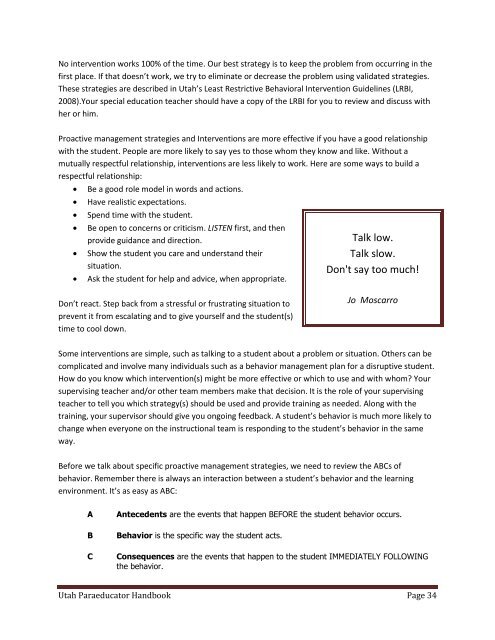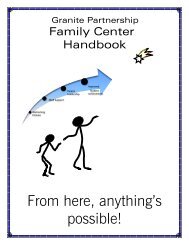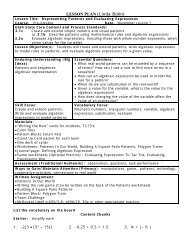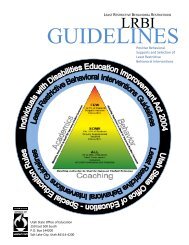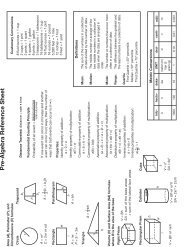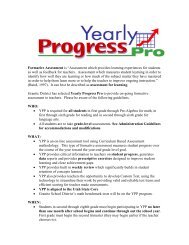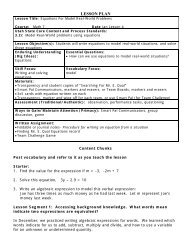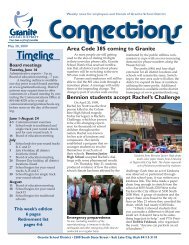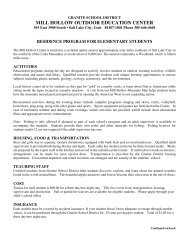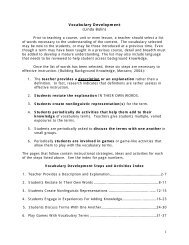Utah Special Education Paraeducator Handbook - Granite School ...
Utah Special Education Paraeducator Handbook - Granite School ...
Utah Special Education Paraeducator Handbook - Granite School ...
Create successful ePaper yourself
Turn your PDF publications into a flip-book with our unique Google optimized e-Paper software.
No intervention works 100% of the time. Our best strategy is to keep the problem from occurring in the<br />
first place. If that doesn’t work, we try to eliminate or decrease the problem using validated strategies.<br />
These strategies are described in <strong>Utah</strong>’s Least Restrictive Behavioral Intervention Guidelines (LRBI,<br />
2008).Your special education teacher should have a copy of the LRBI for you to review and discuss with<br />
her or him.<br />
Proactive management strategies and Interventions are more effective if you have a good relationship<br />
with the student. People are more likely to say yes to those whom they know and like. Without a<br />
mutually respectful relationship, interventions are less likely to work. Here are some ways to build a<br />
respectful relationship:<br />
<br />
<br />
<br />
<br />
<br />
<br />
Be a good role model in words and actions.<br />
Have realistic expectations.<br />
Spend time with the student.<br />
Be open to concerns or criticism. LISTEN first, and then<br />
provide guidance and direction.<br />
Show the student you care and understand their<br />
situation.<br />
Ask the student for help and advice, when appropriate.<br />
Talk low.<br />
Talk slow.<br />
Don't say too much!<br />
Don’t react. Step back from a stressful or frustrating situation to<br />
prevent it from escalating and to give yourself and the student(s)<br />
time to cool down.<br />
Jo Moscarro<br />
Some interventions are simple, such as talking to a student about a problem or situation. Others can be<br />
complicated and involve many individuals such as a behavior management plan for a disruptive student.<br />
How do you know which intervention(s) might be more effective or which to use and with whom? Your<br />
supervising teacher and/or other team members make that decision. It is the role of your supervising<br />
teacher to tell you which strategy(s) should be used and provide training as needed. Along with the<br />
training, your supervisor should give you ongoing feedback. A student’s behavior is much more likely to<br />
change when everyone on the instructional team is responding to the student’s behavior in the same<br />
way.<br />
Before we talk about specific proactive management strategies, we need to review the ABCs of<br />
behavior. Remember there is always an interaction between a student’s behavior and the learning<br />
environment. It’s as easy as ABC:<br />
A<br />
B<br />
C<br />
Antecedents are the events that happen BEFORE the student behavior occurs.<br />
Behavior is the specific way the student acts.<br />
Consequences are the events that happen to the student IMMEDIATELY FOLLOWING<br />
the behavior.<br />
<strong>Utah</strong> <strong>Paraeducator</strong> <strong>Handbook</strong> Page 34


